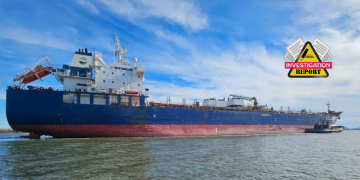Earlier this month, the Xinhua-Baltic International Shipping Centre Development Index was released for 2021, ranking Singapore as the world’s top maritime center for the ninth consecutive year. But what makes a maritime center and which criteria rank one maritime center higher than the other?
There are over 900 container ports in the world, but not all are maritime centers. In 2014, China Economic Information Services, in collaboration with the Baltic Exchange, introduced the first “Xinhua-Baltic International Shipping Centre Development Index”. Drawing analysis from numerous independent datasets, the report aims to identify which factors make up a strong port network, how international shipping centers can be further developed and how they can keep thriving amid the fast-paced disruption of the global shipping industry.
The 10 maritime centers of 2021
Taking a series of factors into consideration, the latest Xinhua-Baltic index identified the following top-10 list of maritime centers:
1. Singapore (Singapore)
2. London (UK)
3. Shanghai (China)
4. Hong Kong (China)
5. Dubai (UAE)
6. Rotterdam (Netherlands)
7. Hamburg (Germany)
8. New York/New Jersey (US)
9. Athens/Piraeus (Greece)
10. Ningbo Zhoushan (China)
DO YOU KNOW?: Read in this series
But how are the rankings decided?
The rankings in the Xinhua-Baltic index are based on three categories:
1.Port factors, such as:
- cargo throughput (including containers, dry bulk, and liquid bulk cargo),
- number of cranes,
- total length of container berths,
- port draught, etc.
2. Shipping services, such as:
- shipping brokerage services,
- shipping engineering services,
- shipping business services,
- maritime legal services,
- shipping finance services, etc.
3. General environment inputs, such as:
- government transparency,
- extent of e-government and administration,
- custom tariff,
- ease of doing business index,
- logistics performance index, etc.
It becomes evident that there is a wide range of characteristics that make a port city an international shipping center, which can be summarized as follows:
1. Advanced logistics systems: Despite the pandemic, Singapore port, which tops the list for the ninth year in a row, handled its second highest ever container throughput at 36.9 million TEUs. According to MarineTraffic, 33,133 vessels exceeding 5000 GT arrived at the port in 2020. Singapore also retained its position as the top bunker port, registering 49.83m tonnes in 2020, its second-highest bunker sales ever and up 5% on the previous year. The global trade disruption caused by the Suez Canal blockade last year caused more ships to arrive at the Shanghai Port, which optimized production scheduling and allocated resources based on intelligent technology and platforms.
2. A key geopolitical location: For example, the port city of Singapore is situated along the Malacca Strait, the “lifeline” of maritime shipping. Malacca Strait links the Pacific Ocean to the Indian Ocean and connects countries in East Asia, Oceania, South Asia, West Asia, Africa, and Europe. Being situated near the Malacca Strait is Singapore’s most significant geographical advantage. The emerging economies in the Asia-Pacific region have spurred strong shipping, which makes Singapore’s geographical advantage even more prominent. Meanwhile, connecting China with the international market, the Shanghai International Shipping Service Centre has the unique location advantage of connecting rivers and seas and communicating with the world.
3. Highly efficient shipping services: Singapore is known for providing a favorable business environment, supportive tariff policy, as well a flexible and user-friendly registration and management system regarding ships and crew. On its turn, London has again topped the Xinhua-Baltic index in the shipping services section of the ranking, coming out on top for law, arbitration, financing, insurance and brokerage services. Meanwhile, after more than ten years of development, Shanghai has significantly grown its market share for ship broking, insurance and legal services.
Did you know?
Despite lagging Singapore in terms of port volumes, London is leading the maritime industry by being home to a number of the maritime sector’s international bodies, such as the International Chamber of Shipping (ICS), the International Association of Classification Societies (IACS), The International Group of P&I and The Baltic Exchange. London is also privileged to host the International Maritime Organization (IMO).
4. Leading-by-example initiatives: Singapore has played an active role in proposing pathways for the decarbonization of the industry and has worked to protect seafarers caught up in the crew change crisis resulting from the Covid-19 pandemic. Rotterdam is firmly backing sustainability through several projects and partnerships and with hydrogen being high on the agenda.
5. Shipping innovation resources: The scientific research strength of universities, research centers, technology companies, start-ups, and other institutions based in Singapore has injected innovation capabilities for future shipping development. In addition, the development of shipping science and technology innovation has become the key driving force at the Shanghai International Shipping Service Center, established in 2015.
“A successful shipping center provides everything that the international shipowner needs. It needs to be an efficient port with good onward connections and offer a competitive port services environment. It needs to be a one-stop shop for the shipowning and chartering community providing access to world-class finance, legal, shipbroking, IT, and classification services. It should be a place, which is able to attract the best international talent. It should have a robust and transparent legal system, backed up by efficient courts and arbitration services,
…explained Mark Jackson, Chief Executive at The Baltic Exchange.



































































































































